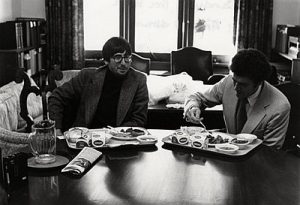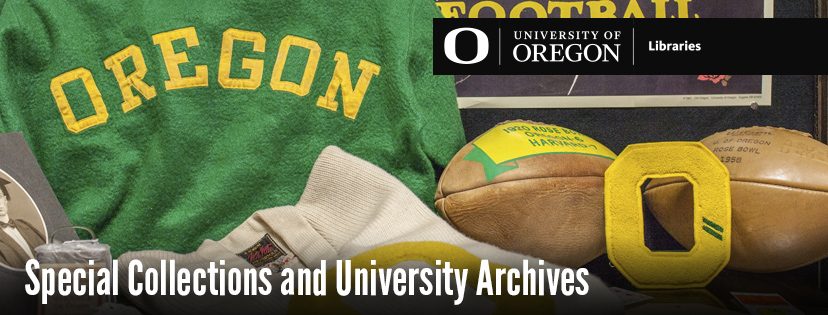The Bureaucracy and Red Tape: President Boyd’s Obstacles to Change at UO
This is the eighth of a series of blog posts highlighting the ongoing work of the Documenting UO History Project within the University Archives. A major part of this project is researching and documenting the often untold and hidden histories of the university’s diverse and underrepresented communities. This year our focus will continue to highlight Black history on campus, specifically Black student activism from the 1960s to present. Prior posts can be seen here.

President William Beaty Boyd served as the University of Oregon President from 1975 to 1980. Boyd is remembered for restructuring the universities administration, and giving the provost predominant control of daily operations. He also worked with production crews from the creators of “Animal House,” and secured a contract so that the Oregon campus could serve as a backdrop for the film. Boyd’s tenure followed an incredibly contentious time for the university, though Boyd enjoyed a relatively calm period for the university. This post highlights his brief tenure and specific achievements related to committees and minority activism.
Although campus protests had significantly tapered since the early 70s, Boyd did face challenging budget cuts and restrictions. These financial difficulties had a direct impact on university growth, particularly on many of the programs and facilities that minority students had been demanding for decades. Like all past university presidents, Boyd has a seemingly endless supply of documentation from his tenure.
What stood out to me most, in fact what helped summarize the obstacles of change that I discovered throughout the entire year of my research of presidential files, was Boyd’s files on university committees. There is a committee for every facet of the university, and even a committee on committees. These committee files are emblematic of the bureaucracy and red tape that any proponent of change at the university must face. The committees are labeled essential for change and are supposed to provide important oversight, yet their members seems to complain that they have very little power.

I found that many of the professor’s responses to invitations to be on the committee on committees was emblematic of ongoing frustrations, and also highlighted the challenges of many university staff and students in regard to the barriers of change. In fact, Professor Barry Siegal wrote a letter to President Boyd declining a committee seat. Siegal wrote, “I have had much experience with this committee and I believe that it is a waste of both faculty and student time to sit on it. I cannot recall one substantial contribution made by it in all of the years of its existence. The failure lies in the inability of the committee to make meaningful changes in an activity which, after all, takes place at the level of each department or in individual classrooms.” (President William Beaty Boyd’s Records UA 001.012, Box 5,Folder 2)
Despite promising past students, most notable, the Black Student Union, a multicultural center, budget restrictions during Boyd’s tenure altered those promises. The Committee on Minority Education appeared to have very little say in the process. Despite being full of letters from community leaders and campus staff urging the dire need for a multi-cultural center on campus, and even the continued urging of the committee covering the project, the center was put to a halt. Committee members were understandably upset, but also confused in regard their purpose and agency.
In another report within the affirmative Action Compliance Committee, the committee was tasked with evaluating opportunities for minority students. The report states, “There are far too few minority students, making up less than 6 percent of the student population, well below the national average… Departments have done very little to recruit minority students, or develop programs to support minority students.” (President William Beaty Boyd’s Records UA 001.012, Box 15, Folder 27). Despite multiple university committees urging for added support and a new multi-cultural center, the decision to drastically slash budgets, drop the multi-cultural center project and halt community outreach to at-risk communities highlighted a historical trend that still plagues the university. Not unlike the Black Student Union’s demands released to University of Oregon President Michael Schill in 2015, which mirrored the demands BSU issued to President Arthur S. Fleming in 1968.
The creation of committees appear to be a necessary tool for input, but are they merely lip service for those who demand change? Regardless of committee urging, many important aspects of university life, including the improvement of support, and recruitment of minority students, disappear as student and community complaints subside. Committee files are filled with letters from students and professors questioning the power and relevance of the very committees they have been appointed to. Look no further than Professor Siegal’s comical response above addressing his appointment to the committee on committees.
What appears to be the case time and time again, the buck stops with the Oregon Board of Trustees, the Oregon State Board of Higher Education and the Chancellor of the University of Oregon System. Although they are rarely referenced in documentation, they appear to have the final  say in financial decisions and any key university changes. The university president certainly plays an important role, but their power appears quite limited by budgetary restrictions, boards and trustees. Whether it is slowly evolving progress, or the staunch patriarchal resistance to fundamental change, the state board, university trustees and chancellor seem to be the gate keepers. To further understand these issues, good or bad, it will be essential for future students and historians to uncover the important roles and agendas of these powerful boards and how to ensure their voices can be heard in these complex hierarchies.
say in financial decisions and any key university changes. The university president certainly plays an important role, but their power appears quite limited by budgetary restrictions, boards and trustees. Whether it is slowly evolving progress, or the staunch patriarchal resistance to fundamental change, the state board, university trustees and chancellor seem to be the gate keepers. To further understand these issues, good or bad, it will be essential for future students and historians to uncover the important roles and agendas of these powerful boards and how to ensure their voices can be heard in these complex hierarchies.
Boyd’s tenure was relatively brief and without controversy. Well before he transitioned from his post as president, Boyd began grooming his predecessor, President Olum. In fact, Boyd’s administrative changes that gave the provost more control of daily operations proved to be the perfect stepping stone for Provost Olum to prepare for his next duty. In the coming weeks, we will cover president Olum’s tenure at Oregon before finishing with well-known President David Frohnmeyer.
Each month new blog posts will include recent findings as part of the overall project and research. This is a very collaborative and open project so we welcome all participation and topic suggestions. This project will only be successful with a diverse community of scholars and students working together to find and document these testimonies. If you or anyone you know is interested in contributing to the process or participating in an oral history interview please contact us.
Joseph Foley
Student Research Assistant
Documenting UO History Project
Sources:
“Office of the President: History.” Accessed June 18, 2017.
President William Beaty Boyd’s Records (UA 001.012), Special Collections and University Archives, University of Oregon, Eugene, Oregon.
Images from University Archives Photographs, UA Ref 3, Special Collections and University Archives, University of Oregon, Eugene, Oregon. Available via Oregon Digital
https://oregonencyclopedia.org/articles/animal_house_film_/#.WU17PWeGPIU
http://journalism.uoregon.edu/~russial/cyberj/thenandnow/boyd.html

